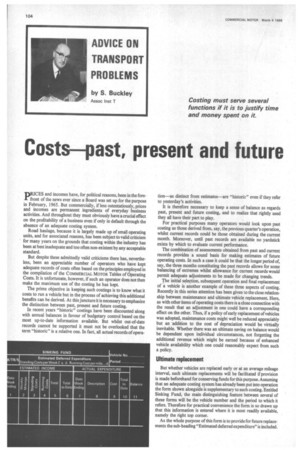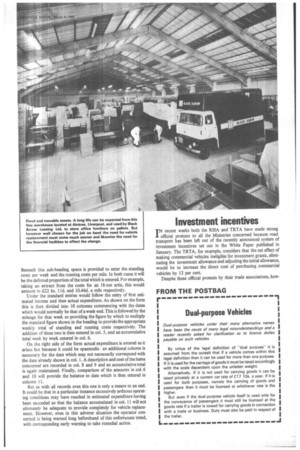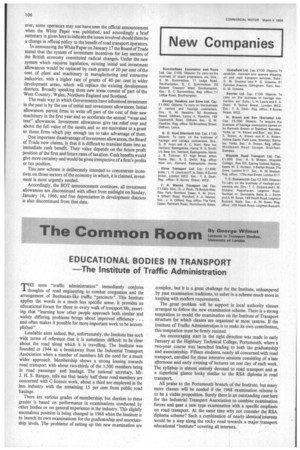Costs—past, present and future
Page 106

Page 107

Page 108

If you've noticed an error in this article please click here to report it so we can fix it.
C ES and incomes have, for political reasons, been in the Pfore front of the news ever since a Board was set up for the purpose in February, 1965. But commercially, if less ostentatiously, prices and incomes are permanent ingredients of everyday business activities. And throughout they must obviously have a crucial effect on the profitability of a business even if only in default through the absence of an adequate costing system.
Road haulage, because it is largely made up of small operating units, and for associated reasons, has been subject to valid criticism for many years on the grounds that costing within the industry has been at best inadequate and too often non-existent by any acceptable standard.
But despite these admittedly valid criticisms there has, nevertheless, been an appreciable number of operators who have kept adequate records of costs often based on the principles employed in the compilation of the COMMERCIAL MOTOR Tables of Operating Costs. It is unfortunate, however, if such an operator does not then make the maximum use of the costing he has kept.
The prime objective in keeping such costings is to know what it costs to run a vehicle but in the process of achieving this additional benefits can be derived. At this juncture it is necessary to emphasize the distinction between past, present and future costing.
In recent years "historic" costings have been discounted along with annual balances in favour of budgetary control based on the most up-to-date information available. But whilst out-of-date records cannot be supported it must not be overlooked that the term "historic" is a relative one. In fact, all actual records of opera
tion—as distinct from estimates—are "historic" even if they refer to yesterday's activities.
It is therefore necessary to keep a sense of balance as regards past, present and future costing, and to realize that rightly used they ail have their part to play.
For practical purposes many operators would look upon past costing as those derived from, say, the previous quarter's operation, whilst current records could be those obtained during the current month. Moreover, until past records are available no yardstick exists by which to evaluate current performance.
The combination of assessments obtained from past and current records provides a sound basis for making estimates of future operating costs. In such a case it could be that the longer period of, say, the three months constituting the past records allows for some balancing of extremes whilst allowance for current records would permit adequate adjustments to be made for changing trends.
The initial selection, subsequent operation and final replacement of a vehicle is another example of these three aspects of costing. Recently in this series attention has been given to the close relationship between maintenance and ultimate vehicle replacement. Here, as with other items of operating costs there is a close connection with the result that an adjustment in one could have a corresponding effect on the other. Thus, if a policy of early replacement of vehicles was adopted, maintenance costs might well be reduced appreciably but an addition to the cost of depreciation would be virtually inevitable. Whether there was an ultimate saving on balance would be dependent upon individual circumstances, not forgetting the additional revenue which might be earned because of enhanced vehicle availability which one could reasonably expect from such a policy.
Ultimate replacement But whether vehicles are replaced early or at an average mileage interval, such ultimate replacements will be facilitated if provision is made beforehand for conserving funds for this purpose. Assuming that an adequate costing system has already been put into operation the form shown alongside is supplementary to such costing. Entitled Sinking Fund, the main distinguishing feature between several of these forms will be the vehicle number and the period to which it refers. Therefore for practical convenience the form is so drawn up that this information is entered where it is most readily available, namely the right top corner.
As the whole purpose of this form is to provide for future replacements the sub-heading "Estimated deferred expenditure" is included. Beneath this sub-heading space is provided to enter the standing costs per week and the running costs per mile. In both cases it will be the deferred proportion of the total which is entered. For example, taking an extract from the costs for an 18-ton artic, this would amount to £22 6s. 11d. and 10.46d. a mile respectively.
Under the standard entries would follow the entry of first estimated income and then actual expenditure. As shown on the form this is then divided into 10 columns commencing with the dates which would normally be that of a week-end. This is followed by the mileage for that week so providing the figure by which to multiply the standard figure shown in the heading to provide the appropriate weekly total of standing and running costs respectively. The addition of these two is then entered in col. 5, and an accumulative total week by week entered in col. 6.
On the right side of the form actual expenditure is entered as it arises but because it could be spasmodic an additional column is necessary for the date which may not necessarily correspond with the date already shown in col. 1. A description and cost of the items concerned are recorded in col. 8 and 9 and an accumulative total is again maintained. Finally, comparison of the amounts in col. 6 and 10 will provide the balance to date which is then entered in column 11.
But as with all records even this one is only a means to an end. It could be that in a particular instance excessively arduous operating conditions may have resulted in estimated expenditure having been exceeded so that the balance accumulated in col. 11 will not ultimately be adequate to provide completely for vehicle replacement. However, even in this adverse situation the operator concerned is being warned long beforehand of this unfortunate trend, with corresponding early warning to take remedial action.
Investment incentives
recent weeks both the RHA and TRTA have made strong official protests to all the Ministries concerned because road transport has been left out of the recently announced system of investment incentives set out in the White Paper published in January. The TRTA, for example, considers that the net effect of making commercial vehicles ineligible for investment grants, eliminating the investment allowance and adjusting the initial allowance, would be to increase the direct cost of purchasing commercial vehicles by 12 per cent.
Despite these official protests by their trade associations, how ever, some operators may not have seen the official announcement when the White Paper was published, and accordingly a brief summary is given here to indicate the issues involved should there be a change in official policy to the benefit of road transport operators.
In announcing the White Paper on January 17 the Board of Trade stated that the system of investment incentives for key sectors of the British economy constituted radical changes. Under the new system which requires legislation, existing initial and investment allowances would be replaced by cash grants of 20 per cent of the cost of plant and machinery in manufacturing and extractive industries, with a higher rate of grants of 40 per cent in wider development areas, which will replace the existing development districts. Broadly speaking these new areas consist of part of the West Country, Wales, Northern England and Scotland.
The main way in which Governments have influenced investment in the past is by the use of initial and investment allowances. Initial allowances permit firms to write off part of the cost of their new machinery in the first year and so accelerate the annual "wear and tear" allowances. Investment allowances give tax relief over and above the full value of the assets and so are equivalent to a grant to those firms which pay enough tax to take advantage of them.
One important disadvantage of investment allowances, the Board of Trade now claims, is that it is difficult to translate them into an immediate cash benefit. Their value depends on the future profit position of the firm and future rates of tax ation. Cash benefits would give more certainty and would be given irrespective of a firm's profits or tax position.
This new scheme is deliberately intended to concentrate incentives on those sectors of the economy in which, it is claimed, investment is most urgently needed.
Accordingly, the BOT announcement continues, all investment allowances are discontinued with effect from midnight on Sunday, January 16, 1966, and free depreciation in development districts is also discontinued from that date.
























































































































































